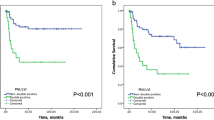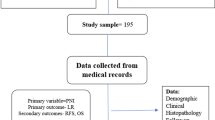Abstract
Background
Although perineural invasion (PNI) has been a poor prognostic factor for head and neck cancers, few studies have focused on oral squamous cell carcinoma (OSCC). The independent significance of PNI in early T1-2 OSCC and the benefit of treatment modification based on PNI status have not been assessed. This study investigated the role of PNI in T1-2 OSCC patients, with focus on the controversial issues of neck management and postoperative adjuvant therapy.
Methods
PNI status was re-reviewed under hematoxylin and eosin staining in tumors of 307 consecutive T1-2 OSCC patients. Oncologic and survival outcomes were analyzed by univariate and multivariate analyses.
Results
PNI was identified in 84 (27.4%) patients, correlating with several established poor prognostic factors. In multivariate analysis, PNI remained an independent predictor for neck metastasis, neck recurrence, and a worse 5-year disease-specific survival. Elective neck dissection contributed to a significantly better 5-year disease-specific survival only in cN0 patients with PNI-positive tumors (P = 0.0071) but not in those with PNI-negative tumors (P = 0.3566). In low-risk patients who were treated by surgery alone, including neck dissection, the 5-year disease-specific survival rates were almost the same in those with PNI-positive tumors and those with PNI-negative tumors (92.0 vs. 92.9%; P = 0.9104).
Conclusions
Elective neck dissection is indicated for cN0 patients with PNI-positive tumors for the efficacy of improving disease-specific survival as well as neck control. However, low-risk PNI-positive patients who undergo neck dissection do not need postoperative adjuvant therapy, because the residual risk from PNI is minimal.


Similar content being viewed by others
References
Beenken SW, Krontiras H, Maddox WA, Peters GE, Soong S, Urist MM. T1 and T2 squamous cell carcinoma of the oral tongue: prognostic factors and the role of elective lymph node dissection. Head Neck. 1999;21:124–30.
Yuen AP, Lam KY, Chan AC, Wei WI, Lam LK, Ho WK, Ho CM. Clinicopathological analysis of elective neck dissection for N0 neck of early oral tongue carcinoma. Am J Surg. 1999;177:90–2.
Yuen AP, Wei WI, Wong YM, Tang KC. Elective neck dissection versus observation in the treatment of early oral tongue carcinoma. Head Neck. 1997;19:583–8.
Vandenbrouck C, Sancho-Garnier H, Chassagne D, Saravane D, Cachin Y, Micheau C. Elective versus therapeutic radical neck dissection in epidermoid carcinoma of the oral cavity: results of a randomized clinical trial. Cancer. 1980;46:386–90.
Yuen AP, Ho CM, Chow TL, et al. Prospective randomized study of selective neck dissection versus observation for N0 neck of early tongue carcinoma. Head Neck. 2009;31:765–72.
D’Cruz AK, Siddachari RC, Walvekar RR, et al. Elective neck dissection for the management of the N0 neck in early cancer of the oral tongue: need for a randomized controlled trial. Head Neck. 2009;31:618–24.
Fakih AR, Rao RS, Borges AM, Patel AR. Elective versus therapeutic neck dissection in early carcinoma of the oral tongue. Am J Surg. 1989;158:309–13.
Cooper JS, Pajak TF, Forastiere A, et al. Precisely defining high-risk operable head and neck tumors based on RTOG #85-03 and #88-24: targets for postoperative radiochemotherapy? Head Neck. 1998;20:588–94.
Langendijk JA, de Jong MA, Leemans CR, de Bree R, Smeele LE, Doornaert P, Slotman BJ. Postoperative radiotherapy in squamous cell carcinoma of the oral cavity: the importance of the overall treatment time. Int J Radiat Oncol Biol Phys. 2003;57:693–700.
Bernier J, Vermorken JB, Koch WM. Adjuvant therapy in patients with resected poor-risk head and neck cancer. J Clin Oncol. 2006;24:2629–35.
O’Brien CJ, Lahr CJ, Soong SJ, Gandour MJ, Jones JM, Urist MM, Maddox WA. Surgical treatment of early-stage carcinoma of the oral tongue: would adjuvant treatment be beneficial? Head Neck Surg. 1986;8:401–8.
Marchesi F, Piemonti L, Mantovani A, Allavena P. Molecular mechanisms of perineural invasion, a forgotten pathway of dissemination and metastasis. Cytokine Growth Factor Rev. 2010;21:77–82.
Fagan JJ, Collins B, Barnes L, D’Amico F, Myers EN, Johnson JT. Perineural invasion in squamous cell carcinoma of the head and neck. Arch Otolaryngol Head Neck Surg. 1998;124:637–40.
Rahima B, Shingaki S, Nagata M, Saito C. Prognostic significance of perineural invasion in oral and oropharyngeal carcinoma. Oral Surg Oral Med Oral Pathol Oral Radiol Endod. 2004;97:423–31.
Pour PM, Bell RH, Batra SK. Neural invasion in the staging of pancreatic cancer. Pancreas. 2003;26:322–5.
Beard CJ, Chen MH, Cote K, Loffredo M, Renshaw AA, Hurwitz M, D’Amico AV. Perineural invasion is associated with increased relapse after external beam radiotherapy for men with low-risk prostate cancer and may be a marker for occult, high-grade cancer. Int J Radiat Oncol Biol Phys. 2004;58:19–24.
Liebig C, Ayala G, Wilks JA, Berger DH, Albo D. Perineural invasion in cancer: a review of the literature. Cancer. 2009;115:3379–91.
Liebig C, Ayala G, Wilks J, et al. Perineural invasion is an independent predictor of outcome in colorectal cancer. J Clin Oncol. 2009;27:5131–7.
Bernier J, Domenge C, Ozsahin M, et al. Postoperative irradiation with or without concomitant chemotherapy for locally advanced head and neck cancer. N Engl J Med. 2004;350:1945–52.
Haddad RI, Shin DM. Recent advances in head and neck cancer. N Engl J Med. 2008;359:1143–54.
National Comprehensive Cancer Network. Head and Neck Cancers. Clinical practice guidelines in oncology-v2. 2011. http://www,nccn.org/index.asp.
College of American Pathologists: Cancer Protocols and Checklists. Northfield, IL: College of American Pathologists, 2010.
Poonacha TK, Go RS. Level of scientific evidence underlying recommendations arising from the National Comprehensive Cancer Network clinical practice guidelines. J Clin Oncol. 2011;29:186–91.
Byers RM, El-Naggar AK, Lee YY, et al. Can we detect or predict the presence of occult nodal metastases in patients with squamous carcinoma of the oral tongue? Head Neck. 1998;20:138–44.
Kurtz KA, Hoffman HT, Zimmerman MB, Robinson RA. Perineural and vascular invasion in oral cavity squamous carcinoma: increased incidence on re-review of slides and by using immunohistochemical enhancement. Arch Pathol Lab Med. 2005;129:354–9.
Liao CT, Chang JT, Wang HM, et al. Does adjuvant radiation therapy improve outcomes in pT1-3N0 oral cavity cancer with tumor-free margins and perineural invasion? Int J Radiat Oncol Biol Phys. 2008;71:371–6.
Soo KC, Carter RL, O’Brien CJ, Barr L, Bliss JM, Shaw HJ. Prognostic implications of perineural spread in squamous carcinomas of the head and neck. Laryngoscope. 1986;96:1145–8.
Carter RL, Tanner NS, Clifford P, Shaw HJ. Perineural spread in squamous cell carcinomas of the head and neck: a clinicopathological study. Clin Otolaryngol Allied Sci. 1979;4:271–81.
Breslow A. Prognostic factors in the treatment of cutaneous melanoma. J Cutan Pathol. 1979;6:208–12.
Laramore GE, Scott CB, al-Sarraf M, et al. Adjuvant chemotherapy for resectable squamous cell carcinomas of the head and neck: report on Intergroup Study 0034. Int J Radiat Oncol Biol Phys. 1992;23:705–13.
Machtay M, Moughan J, Trotti A, et al. Factors associated with severe late toxicity after concurrent chemoradiation for locally advanced head and neck cancer: an RTOG analysis. J Clin Oncol. 2008;26:3582–9.
Cooper JS, Pajak TF, Forastiere AA, et al. Postoperative concurrent radiotherapy and chemotherapy for high-risk squamous-cell carcinoma of the head and neck. N Engl J Med. 2004;350:1937–44.
Morris LG, Sikora AG, Patel SG, Hayes RB, Ganly I. Second primary cancers after an index head and neck cancer: subsite-specific trends in the era of human papillomavirus-associated oropharyngeal cancer. J Clin Oncol. 2011;29:739–46.
Acknowledgment
We thank the Clinical Research Core Laboratory, Taipei Veterans General Hospital, for technical assistance. This work was supported in part by National Science Council of Taiwan (grant number NSC 98-2314-B-010-013-MY3), and Taipei Veterans General Hospital (grant numbers V98C1-169, V99C1-117, V100C-090).
Conflict of interest
The authors declare no conflict of interest.
Author information
Authors and Affiliations
Corresponding author
Rights and permissions
About this article
Cite this article
Tai, SK., Li, WY., Yang, MH. et al. Treatment for T1-2 Oral Squamous Cell Carcinoma with or Without Perineural Invasion: Neck Dissection and Postoperative Adjuvant Therapy. Ann Surg Oncol 19, 1995–2002 (2012). https://doi.org/10.1245/s10434-011-2182-5
Received:
Published:
Issue Date:
DOI: https://doi.org/10.1245/s10434-011-2182-5




